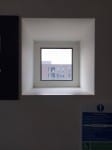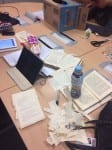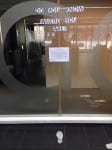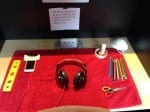FRAMING STATEMENT
“SITE-SPECIFIC PERFORMANCE EXISTS WITHIN A PLETHORA OF PHENOMENA, ALL COMPETING FOR ATTENTION, ALL POTENTIALLY MEANINGFUL: A CONCATENATION OF THAT AT SITE AND THAT BROUGHT TO THE SITE” (Pearson 2010)
The journey for me has been very frustrating in the sense that I had to lose my inhibitions and follow my initiative with confidence. Site specific, I have realised, cannot be defined, it only matters what space you are in and what you as an individual person can understand and interpret from feeling the space. McLucas states that the performance, the place and the public creates a ‘deep engagement…that constitutes site specific work’ (McLucas, 1993), the combination of the three allowed us to create a piece that was dependant on the place and the audience to take part in, therefore creating a site specific performance. Our finally piece was dictated through two works, Dream Think Speak’s ‘One Day, Maybe’ and an article from the Lincolnshire Magazine called ‘What is Art?’. From One Day, Maybe, Tristan Sharp states that he didn’t want to recreate the scenes of the democracy protests in South Korea but ‘recreate the spirit’ (Sharp, 2013). This is what we wanted in our piece, only to create the spirit rather than perform a recreation of history. We also did not want to recreate something in a space because that would involve having to ‘re-enact millions and millions of occurrences which have happened’ (Pearson and Shanks, 2001) in the space, something that we would never be able to do, therefore the spirit of the history only gave it more ambiance.
Our final piece was called ‘DO YOU KNOW WHERE YOU ARE?’ and the performers were myself, Benjamin Rowan and Kerrie Crockford. It was a journey throughout the library, but started just in front of the barriers when just coming into the library itself. The audience would have to follow the footsteps through to the stairs where they would be given a package and directed to follow the footsteps to the third floor where they would be greeted by someone. On the trail they would come into contact with quotes on the wall from an article that was taken from the Lincolnshire Magazine from 1931, as well as indication for the audience to look at places that they might not have noticed usually. For example we had arrows pointing towards the writing on the side of the library that had the ‘Goods and Grains’ sign that has been cut off. They will be taken through the third floor to the cubicles at the back of the library where they will be sat down and instructed to listen to an audio through headphones. On the audio is a slowed down audio of the third floor of the library, with a voiceover that instructs the audience to build something with the materials in the package that they brought through the trail with them. Once the audio had finished they would walk back down backwards through the trail to the beginning. The performance took place over the course of nine hours from 9am – 6pm and then the installation took place 7 pm – 9pm on the 5th of May.

ANALYSIS OF THE PROCESS
Our main idea throughout the journey was to get a room in the library and completely transform the space, we wanted to transform it into some kind of fortress for the audience. After interviewing people in the library we asked if they ever enjoyed being at the library and an overall the resounding answer was that it was not an enjoyable process but it was necessary. This only pushed us further to create a performance that made the audience feels as if they were completely in a different world. We wanted to have a fortress with a mystical slant because after talking to a lot of students who attend the library regularly we noticed that the only reason to go the library is to get out books that are only for academic use, however public university are mostly used, especially as children, to get out fiction books. We wanted to bring in the world of fiction to the library, a world to get away from the stress of university and exams. Initially we wanted to have a mixture between the machinery and the books by having a journey through two rooms that would end in the mystical fortress that was made entirely of paper and books. However after showing this in our original proposal to the library staff and the module leader we realised that though this was an ambitious idea, though it was doable it may have been too complicated therefore the actual meaning would have been lost in translation. After looking at ‘The Book as Art’ we had a realisation what we can do with books and bringing the story to life into a room will allow us to bring the audience into a realm. The journey through the machinery and metal fortress also showed how far the library has come and represented the library as a warehouse but also as a library.

In our group we all had dance backgrounds and enjoyed physical theatre and dance, therefore we wanted to incorporate it into our performance in some way. We started to come up with ideas that focused around a room that we had wanted to have our piece from the beginning however it began to limit our ideas and not allow us to progress with our ideas further. Therefore we went to the dance studio and improvised in the space, interacting with each other and trying to find ways in which we could connect our bodies, this is when we came up with the idea to create a machine with our bodies. We also looked at DV8 and their work with John, a verbatim performance that looks at crime and drug use. In a particular scene called Achievements (see below), John recites a monologue and uses physical theatre in time with a ticking clock at the same time. This rhythmic movement inspired us to look at rhythm and machinery clockwork and the assembly line to attach the performance to the history of the library.
(dv8physicaltheatre, 2015)
Originally, our idea was to look at the difference between the contemporary space and the original brick work. From the pictures, as seen above, we were looking at splitting the room into half and having the two different states that are in the library. Initially we were looking at using technology and the transformation, and the way in which people learn, whether it be with books or with computers. In this we wanted to take the audience on a journey, and after looking at Before I Sleep, from Dream Think Speak, the process of the audience getting to choose their path was something that interested us. In Before I Sleep, the artistic director Tristan Sharp wanted to them ‘not to be led through’ (Sharp, 2010) the performance but for them to make their own way, this is why we wanted, in our final piece for the audience just to follow the footsteps if they wish, rather than be led by one of the performers.
From all of our ideas in our journey, we realised that we wanted our performance to be an immersive experience for our audience, rather than a visual that they would just have to observe. Initially we wanted to have an installation, however we felt, as an immersive experience, we needed to perform and engage the audience further, this is why we led onto focussing on the sensory aspect. We wanted to bring them into space that was familiar but also unfamiliar to the senses, this is what led to us using audio for our final performance. We wanted to ‘immerse the audience sensually, not in an artificial world, but within the immediate, real space of the performance’ (Kilch, 2012)), we did not want the space to be considered something unfamiliar but just a familiar space that seemed warped, this is why we wanted our audience to be transported to back into the warehouse state of the Library. For the senses we wanted to transform the room we originally had in mind into a warehouse, but with sound and smell. We wanted to use the strong smell of oil and the sound of steel that we had recorded ourselves. I also looking into an interview from The Future of Story Telling who interviewed Felix Barrett, the artistic director of Punchdrunk. In this interview Barrett was discussing his productions The Drowned Man and Sleep No More, he speaks of the experience he wanted the audience to have and that he wanted them in a ‘heightened state of awareness’ (Barrett, 2013), he did not want his performances to be just an observation but to be immersed into another reality. Barrett also wanted the audience to feel this familiar but unfamiliar sense that we wanted in our performance. He says he wants the audience to feel as if the ‘roads you might have walked hundreds of times before…suddenly you see with a magic hour veneer, because you are living it in a different way.’(Barrett, 2013). I feel as if we achieved this in our performance as from an interview with the audience members one stated ‘I felt as if it had been years since I had been in the library, as if I had been gone and it had changed, when in fact it had only be twenty minutes, and my perception of the library had changed.’(Ventress, 2016).
(WHAT IS ART, 2016)
From our sensory idea we wanted to focus on just the audio aspect of the senses. When we were looking for information on the library, as a group we went into the local history section of the library and for six hours looked through as much as could on the history of the library until we looked through The Lincolnshire Magazines that dated back to 1924, after looking for a while we found an article called ‘What is Art?’, from this we found out that there was a Arts school that was at the top of Steep Hill near the Cathedral and the article was written by Austin Garland who was the Headmaster of Lincoln School of Art. In this article he spoke of the workman of the time and how technology had surpassed their skills in their field, and how their skill in their field is art in itself. From this article we felt as if we had combined all of our ideas together and we could create an entirely new piece.
PERFORMANCE EVALUATION

Overall for our performance we had twenty six audience members that took part in the immersive experience. After our performance I interviewed some of the audience members on their thoughts about the piece itself. One of the audience members describes it as a ‘visceral and creative experience. I’ve not considered the library to be a creative place before, but now I will associate it with creativity.’ (Cummings, 2016)
After being in the space for our final performance, it brought a long with it a new feeling and look towards the library, as the twelve hour performance had never been performed other than on the day it gave a lot of time for reflection, to study how people act on the third floor, where our piece ended. From the performance day we were thinking about how to progress our idea further, we thought about going back to one of our progressive ideas through our journey and how sound can be overlapped to create a menagerie of sound and immerse the audience into a completely different space.
What worked well in our final piece was the audio at the end of the trail. It was received well from the audience and the way in which I had edited the sound was received as I intended from the audience. They felt as if they were disconnected from the physical space they were in, describing it as ‘therapeutic’ (Lomas,2016) and they were ‘disengaged’ (Lomas, 2016) from the space around them.
I think at the end of the performance what we could have improved upon is making the trail more immersive rather than just a visual. Originally we were going to have the audience pick out what type of audience member they were, we found this in Pearson’s Site Specific Performance. In the text it mentions eight types of audience members, and our plan was to create a station that allowed the audience to pick which one they were, this, however became a challenge. The reason it was not plausible for our piece was that we did not have enough performers to station all of the places on our trail, as there was only three of us in a group.
It we were to perform it again I would have used different materials that the audience had to build for their sculpture. The reason I would change it is because we needed materials that would stick together a lot easier for our installation after wards because at its current state it was very disjointed and not connected, which was the point of the installation; to connect everyone’s work in one installation. To do this we could have used just nuts and bolt and things that could be screwed together, however every audience member is different and the unknown that we as performers were experiencing as they built their individual sculpture. However in ‘What is Art?’ it states that ‘if we have no clear conception of the complete object, we cannot proceed in an orderly fashion with its construction, and a clumsy and ill made thing will result.’ (Garland, 1931). What I would have altered in our performance was to make this statement more clear in our intentions, because without it, it just looked messy, which was not our intent.

Having a non-traditional venues as our performance space has taken a lot of getting used to, and performing experimental performance art has also taken me out of my comfort zone on this journey. To be able to follow my initiative and not worry about the people around me and their views has been the hardest challenge of Site Specific Performance, being a very self-aware person has limited me in a sense. However, through exercises in class, such as physically interacting through improvisation with peers that I would generally not worked with has helped me realise the potential that I have to think of non-traditional performance in non-traditional spaces.
Overall the reason we were so passionate about our final idea was because we could finally say that our idea was site specific. Our piece was dependent on our space, for you cannot do it in any other space or location that would give the same impact and relevant reaction. After finding the ‘What is Art‘ article from The Lincolnshire Magazine from 1931 we looked at the emphasis on workmen making parts of something bigger, and using their skill to create a cog in a large machine. From getting our primary research from the local history section of the library we can add it to it being site specific, for example if we put this piece into Nottingham Library it would not have the same historical context as University of Lincoln Library. Slowing down the audio that was taken from the third floor gave morphed view of the third floor, as it began to sound like banging and possibly even steel. Therefore gradually slowing down this one piece of audio down could take the audience back to the steel works, transforming the space around them, throwing them into the history.
Word Count : 2541
Citation List
Brighton Festival (2010) Tristan Sharps from dreamthinkspeak gives an insight into new piece – Before I Sleep Available from https://www.youtube.com/watch?v=DvcLqo_9isc [accessed 2 March 2016].
Crockford, K. (2016) Lincoln. Print
Cummings, W. (2016) Questions on our Site-Specific Performance. [interview] Interviewed by Jessica Franklin, 10 May.
Dreamthinkspeak (2013) ONE DAY, MAYBE by dreamthinkspeak Available from https://www.youtube.com/watch?v=yLUeQ90hu-Q [accessed 29 February 2016]
DV8 Physical Theatre (2015) DV8 Physical Theatre | JOHN: Achievements Available from https://www.youtube.com/watch?v=9N4LWVSkH1s [accessed 20 March 2016].
Franklin, J.(2016) Lincoln. Print
Franklin, J.(2016) WHAT IS ART? Lincoln. Audio
Future of Storytelling (2013) Burn the Seats: Felix Barrett (Future of StoryTelling 2013) Available from https://www.youtube.com/watch?v=6ktpes0qMZ0 [accessed 15 February 2016].
Garland, A (1931) What is Art? The Lincolnshire Magazine. 26,72. Lincoln
Kilch, R. and Scheer, E. (2013) Multimedia Performance. Basingstoke: Palgrave Macmillan.
Lomas, H. (2016) Questions on our Site-Specific Performance. [interview] Interviewed by Jessica Franklin, 10 May.
McLucas, C. (1993) The Host and The Ghost.
Pearson, M. (2010) Site-specific Performance. Basingstoke: Palgrave Macmillan.
Pearson, M and Shanks, M (2001) Theatre/Archaeology. London: Routledge.
Ventress, O. (2016) Questions on our Site-Specific Performance. [interview] Interviewed by Jessica Franklin, 1o May.